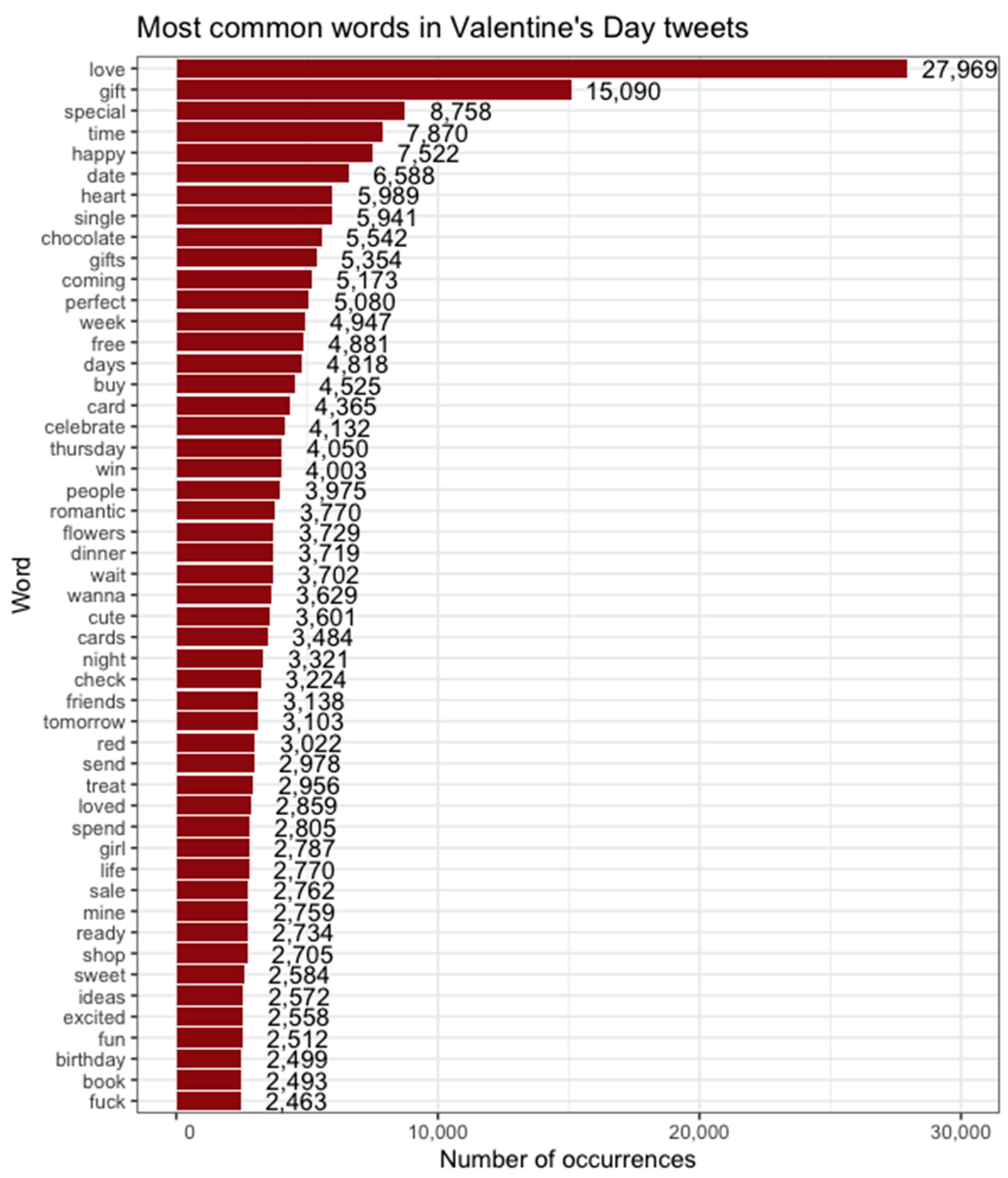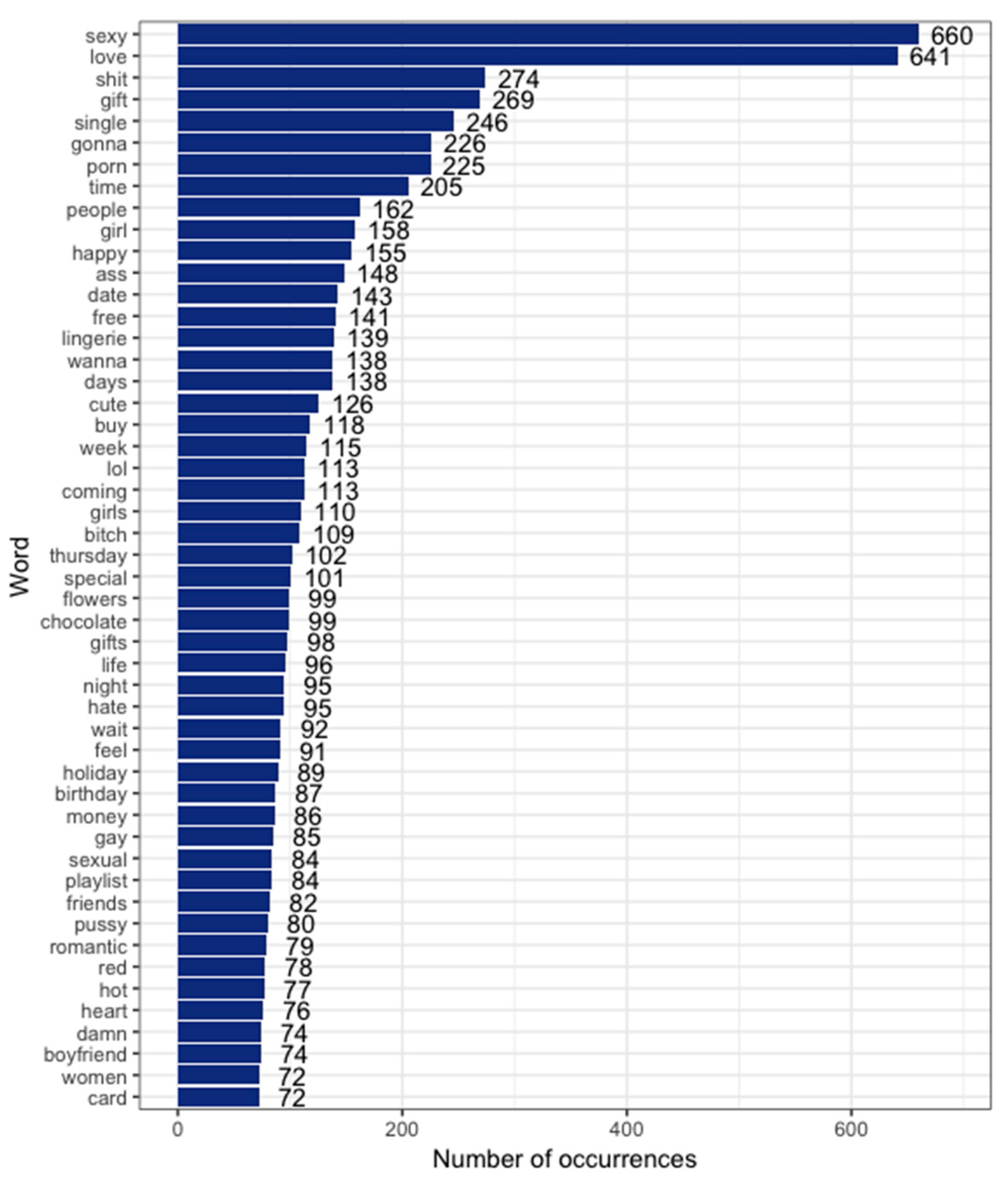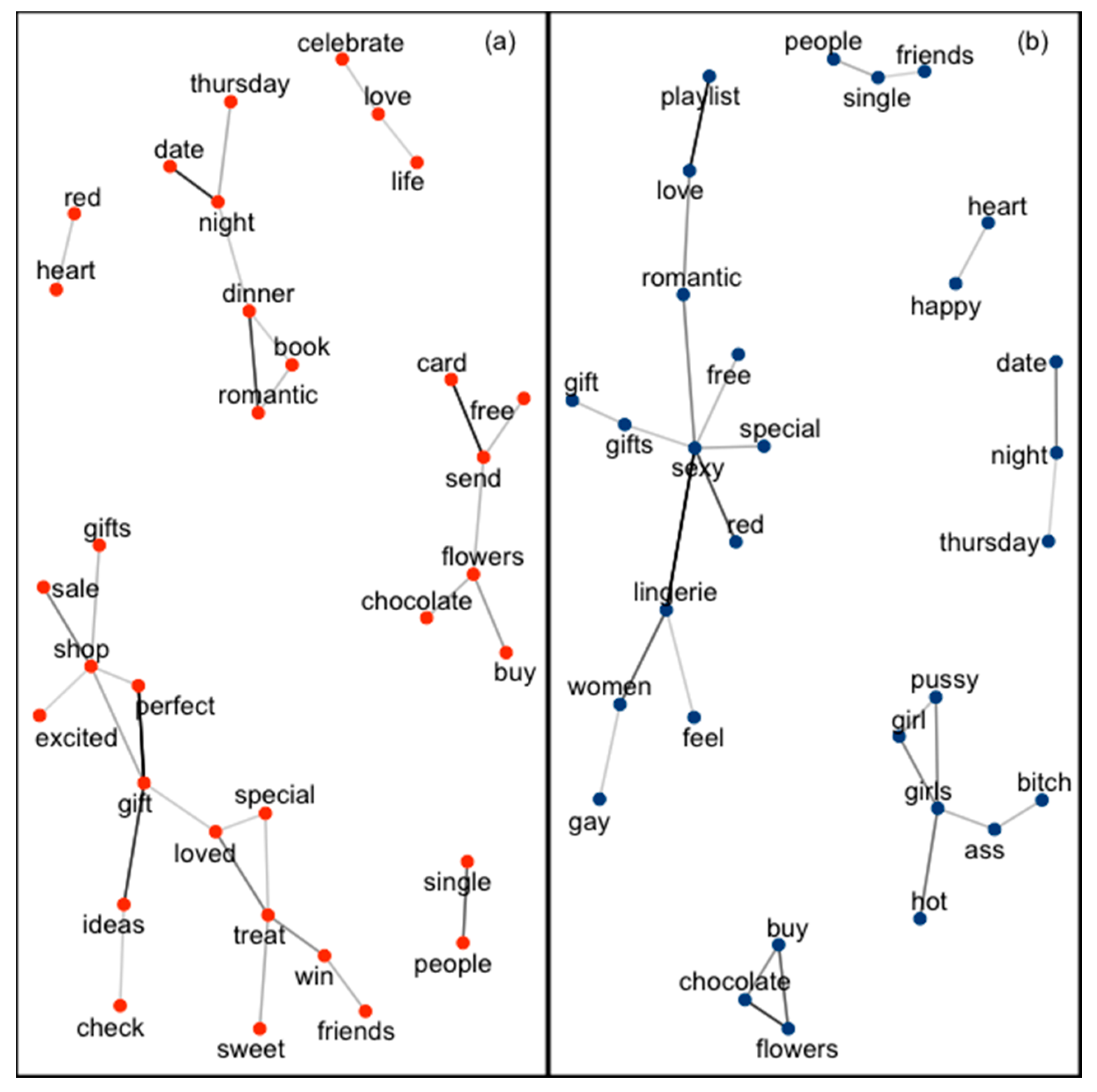The Social Aspects of Sexual Health: A Twitter-Based Analysis of Valentine’s Day Perception
Abstract
1. Introduction
2. Materials and Methods
2.1. Data Collection
2.2. Data Analysis
3. Results
4. Discussion
5. Conclusions
Author Contributions
Funding
Institutional Review Board Statement
Informed Consent Statement
Data Availability Statement
Conflicts of Interest
References
- Conferenza Episcopale Italiana. Martirologio Romano—Riformato a Norma dei Decreti del Concilio Ecumenico Vaticano II e Promulgato da Papa Giovanni Paolo II; Libreria Editrice Vaticana: Città del Vaticano, 2004. [Google Scholar]
- Holloway, S. Love, Custom & Consumption: Valentine’s Day in England c. 1660–1830. Cult. Soc. Hist. 2019, 17, 295–314. [Google Scholar] [CrossRef]
- Groom, N. Hallowe’en and Valentine: The Culture of Saints’ Days in the English-Speaking World. Folklore 2018, 129, 331–352. [Google Scholar] [CrossRef]
- Close Scheinbaum, A.; Zinkhan, G. A Holiday Loved and Loathed: A Consumer Perspective of Valentine’s Day. Adv. Consum. Res. 2006, 33, 356–365. [Google Scholar]
- Close, A.G.; Zinkhan, G.M. Market-resistance and Valentine’s Day events. J. Bus. Res. 2009, 62, 200–207. [Google Scholar] [CrossRef]
- Davenport, S.M.; Birtle, J. Association between parasuicide and Saint Valentine’s Day. BMJ 1990, 300, 783–784. [Google Scholar] [CrossRef]
- Barker, E.; O’Gorman, J.; De Leo, D. Suicide around public holidays. Australas Psychiatry 2014, 22, 122–126. [Google Scholar] [CrossRef]
- Lench, H.C.; Safer, M.A.; Levine, L.J. Focalism and the underestimation of future emotion: When it’s worse than imagined. Emotion 2011, 11, 278–285. [Google Scholar] [CrossRef]
- Sorensen, S.; Pinquart, M. Preparation for future care needs: Styles of preparation used by older Eastern German, United States, and Canadian women. J. Cross Cult. Gerontol. 2000, 15, 349–381. [Google Scholar] [CrossRef]
- Hoerger, M.; Quirk, S.W. Affective forecasting and the Big Five. Pers. Individ. Differ. 2010, 49, 972–976. [Google Scholar] [CrossRef][Green Version]
- Martin, S.M.; Quirk, S.W. Social anxiety and the accuracy of predicted affect. Cogn. Emot. 2015, 29, 51–63. [Google Scholar] [CrossRef]
- Kristal, A.C.; O’Brien, E.; Caruso, E.M. Yesterday’s News: A Temporal Discontinuity in the Sting of Inferiority. Psychol. Sci. 2019, 30, 643–656. [Google Scholar] [CrossRef] [PubMed]
- Passerello, G.L.; Hazelwood, J.E.; Lawrie, S. Using Twitter to assess attitudes to schizophrenia and psychosis. BJPsych Bull. 2019, 43, 158–166. [Google Scholar] [CrossRef] [PubMed]
- Gabarron, E.; Dorronzoro, E.; Rivera-Romero, O.; Wynn, R. Diabetes on Twitter: A Sentiment Analysis. J. Diabetes Sci. Technol. 2019, 13, 439–444. [Google Scholar] [CrossRef]
- Goff, D.A.; Kullar, R.; Laxminarayan, R.; Mendelson, M.; Nathwani, D.; Osterholm, M. Twitter to engage, educate, and advocate for global antibiotic stewardship and antimicrobial resistance. Lancet Infect. Dis. 2019, 19, 229–231. [Google Scholar] [CrossRef]
- Parwani, P.; Choi, A.D.; Lopez-Mattei, J.; Raza, S.; Chen, T.; Narang, A.; Michos, E.D.; Erwin, J.P., 3rd; Mamas, M.A.; Gulati, M. Understanding Social Media: Opportunities for Cardiovascular Medicine. J. Am. Coll. Cardiol. 2019, 73, 1089–1093. [Google Scholar] [CrossRef]
- Boon-Itt, S.; Skunkan, Y. Public Perception of the COVID-19 Pandemic on Twitter: Sentiment Analysis and Topic Modeling Study. JMIR Public Health Surveill. 2020, 6, e21978. [Google Scholar] [CrossRef] [PubMed]
- Cignarelli, A.; Sansone, A.; Caruso, I.; Perrini, S.; Natalicchio, A.; Laviola, L.; Jannini, E.A.; Giorgino, F. Diabetes in the Time of COVID-19: A Twitter-Based Sentiment Analysis. J. Diabetes Sci. Technol. 2020, 14, 1131–1132. [Google Scholar] [CrossRef]
- Berkovic, D.; Ackerman, I.N.; Briggs, A.M.; Ayton, D. Tweets by People with Arthritis During the COVID-19 Pandemic: Content and Sentiment Analysis. J. Med. Internet Res. 2020, 22, e24550. [Google Scholar] [CrossRef]
- Sansone, A.; Cignarelli, A.; Ciocca, G.; Pozza, C.; Giorgino, F.; Romanelli, F.; Jannini, E.A. The Sentiment Analysis of Tweets as a New Tool to Measure Public Perception of Male Erectile and Ejaculatory Dysfunctions. Sex. Med. 2019, 7, 464–471. [Google Scholar] [CrossRef]
- Trovato, C.M.; Montuori, M.; Oliva, S.; Cucchiara, S.; Cignarelli, A.; Sansone, A. Assessment of public perceptions and concerns of celiac disease: A Twitter-based sentiment analysis study. Dig. Liver Dis. 2020, 52, 464–466. [Google Scholar] [CrossRef]
- Galvani, A.P.; Signorini, A.; Segre, A.M.; Polgreen, P.M. The Use of Twitter to Track Levels of Disease Activity and Public Concern in the U.S. during the Influenza a H1N1 Pandemic. PLoS ONE 2011, 6. [Google Scholar] [CrossRef]
- Kearney, M.W. rtweet: Collecting Twitter Data. JOSS 2018. [Google Scholar] [CrossRef]
- Wickham, H. Romain François, Lionel Henry and Kirill Müller (2020). dplyr: A Grammar of Data Manipulation. R Package Version 1.0.2. Available online: https://CRAN.R-project.org/package=dplyr (accessed on 18 August 2020).
- Silge, J.; Robinson, D. tidytext: Text Mining and Analysis Using Tidy Data Principles in R. J. Open Source Softw. 2016, 1, 37. [Google Scholar] [CrossRef]
- Wickham, H. ggplot2: Elegant Graphics for Data Analysis; Springer: New York, NY, USA, 2009. [Google Scholar]
- Parker, G.; Parker, I.; Brotchie, H. Mood state effects of chocolate. J. Affect. Disord. 2006, 92, 149–159. [Google Scholar] [CrossRef] [PubMed]
- Salonia, A.; Fabbri, F.; Zanni, G.; Scavini, M.; Fantini, G.V.; Briganti, A.; Naspro, R.; Parazzini, F.; Gori, E.; Rigatti, P.; et al. Chocolate and women’s sexual health: An intriguing correlation. J. Sex. Med. 2006, 3, 476–482. [Google Scholar] [CrossRef]
- Lippi, D. Chocolate and medicine: Dangerous liaisons? Nutrition 2009, 25, 1100–1103. [Google Scholar] [CrossRef]
- Netemeyer, R.G.; Andrews, J.C.; Durvasula, S. A Comparison of Three Behavioral Intention Models: The Case of Valentine’s Day Gift-Giving. Adv. Consum. Res. 1993, 20, 135–141. [Google Scholar]
- Otnes, C.; Ruth, J.A.; Milbourne, C.C. The Pleasure and Pain of Being Close: Men’s Mixed Feelings About Participation in Valentine’s Day Gift Exchange. Adv. Consum. Res. 1994, 21, 159–164. [Google Scholar]
- Zayas, V.; Pandey, G.; Tabak, J. Red Roses and Gift Chocolates Are Judged More Positively in the U.S. Near Valentine’s Day: Evidence of Naturally Occurring Cultural Priming. Front. Psychol. 2017, 8, 355. [Google Scholar] [CrossRef]
- Aleccia, J. V is for Valentine’s Day—And Viagra, Data Show. Available online: http://www.nbcnews.com/id/41495537/ns/health-mens_health/t/v-valentines-day-viagra-data-show/ (accessed on 22 August 2019).
- Jannini, E.A.; Lenzi, A.; Isidori, A.; Fabbri, A. COMMENTARY: Subclinical Erectile Dysfunction: Proposal for a Novel Taxonomic Category in Sexual Medicine. J. Sex. Med. 2006, 3, 787–794. [Google Scholar] [CrossRef]
- Pratchett, T. Thief of Time: A Novel of Discworld, 1st ed.; HarperCollins: New York, NY, USA, 2001; 324p. [Google Scholar]




Publisher’s Note: MDPI stays neutral with regard to jurisdictional claims in published maps and institutional affiliations. |
© 2021 by the authors. Licensee MDPI, Basel, Switzerland. This article is an open access article distributed under the terms and conditions of the Creative Commons Attribution (CC BY) license (http://creativecommons.org/licenses/by/4.0/).
Share and Cite
Sansone, A.; Cignarelli, A.; Mollaioli, D.; Ciocca, G.; Limoncin, E.; Romanelli, F.; Balercia, G.; Jannini, E.A. The Social Aspects of Sexual Health: A Twitter-Based Analysis of Valentine’s Day Perception. Sexes 2021, 2, 50-59. https://doi.org/10.3390/sexes2010004
Sansone A, Cignarelli A, Mollaioli D, Ciocca G, Limoncin E, Romanelli F, Balercia G, Jannini EA. The Social Aspects of Sexual Health: A Twitter-Based Analysis of Valentine’s Day Perception. Sexes. 2021; 2(1):50-59. https://doi.org/10.3390/sexes2010004
Chicago/Turabian StyleSansone, Andrea, Angelo Cignarelli, Daniele Mollaioli, Giacomo Ciocca, Erika Limoncin, Francesco Romanelli, Giancarlo Balercia, and Emmanuele A. Jannini. 2021. "The Social Aspects of Sexual Health: A Twitter-Based Analysis of Valentine’s Day Perception" Sexes 2, no. 1: 50-59. https://doi.org/10.3390/sexes2010004
APA StyleSansone, A., Cignarelli, A., Mollaioli, D., Ciocca, G., Limoncin, E., Romanelli, F., Balercia, G., & Jannini, E. A. (2021). The Social Aspects of Sexual Health: A Twitter-Based Analysis of Valentine’s Day Perception. Sexes, 2(1), 50-59. https://doi.org/10.3390/sexes2010004









